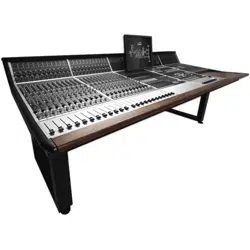Loading ...
Loading ...
Loading ...

THE MIX BUS
The Mix Bus is the two channel bus that your
mix is summed into. On the ASP8024-HE,
the summing bus is active and uses a pair of
Jenson
TM
990C+, fully Discrete Op-Amps. This
offers a fast punchy sound, minimal crosstalk
and an extremely low noise oor. This then
runs into the Heritage output card, which gives
additional tone shaping options.
The rst option is RETRO IRON, which runs
the signal through a vintage style amplication
stage followed by a pair of Carnhill Transformers
- adding extra weight and warmth to the output.
The transformers also add body and punch to
the low end and a little bit of top end sparkle.
With the RETRO IRON Card switched in, you
can also switch in two Baxandall EQ stages:
Low Bump adds a 2dB boost at 60Hz, this
helps push kick drums and bass forward in the
mix and tightens the low end. High Lift adds a
2dB boost at 20kHz which will make cymbals
sparkle and make vocals more present.
The Mix Bus Insert is located after the Heritage
Output Card and allows you to apply outboard
effects to the entire mix. Plug your outboard
gear into the two mix inserts, one for the left
channel, and one for the right. We recommend
using stereo or stereo linked units, or two
identical units with switched controls. Two
units with continuous controls can be used,
however care must be taken to match the units
to prevent imbalance across the stereo eld.
ADDING MIX BUS COMPRESSION
After the insert is the Mix Bus Compressor, a
Soft Knee VCA compressor, optimised for Mix
Bus use. To insert the compressor into the Mix
bus simply press the IN button.
The Threshold controls at which amplitude the
Compressor begins to compress the signal.
As it is reduced, more of the signal will be
compressed. The Ratio controls by how much
the signal above the threshold is reduced. A
ratio of 2:1 reduces the level by a factor of two,
a ratio of 4:1 reduces the level by a factor of 4
etc.
The Attack and Release controls can be used to
further affect the way the mix is compressed.
The attack controls how quickly the
Compressor reacts when the signal amplitude
moves above the threshold. A slow setting will
result in fast transient signals being compressed
less, and a faster setting means transients will
be compressed with the rest of the signal. The
release controls how quickly the Compressor
stops affecting the signal once it falls below the
threshold level.
The Mix Bus Compressor features a further
feature, labeled Bass Expand. This adds a 350Hz
high-pass lter to the sidechain, which means
low frequencies won’t cause the Compressor
to activate. This can help to give a more full,
consistent low-end.
As the signal is compressed, the overall level
will be reduced, especially when compressing
harshly. To bring the signal back up to its original
level, use the Make-up Gain Knob. Switching
the Compressor in and out and listening for a
volume difference or using the Master Meters
allows you to quickly set you make up gain.
CAPTURING YOUR FINAL MIX
Once you are happy with the mix, it can be
captured by connecting one of the Mix Outputs
to your DAW or another recording medium, and
recording the track in its entirety through the
desk. Riding faders, or altering settings during
mixdown provides the analogue equivalent
of DAW automation, while giving a human
element to a mix.
37
Using asp8024-HE
Loading ...
Loading ...
Loading ...
